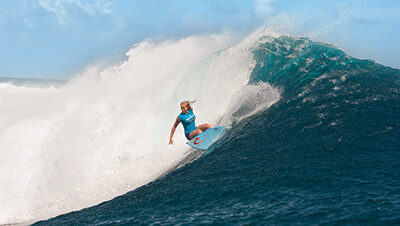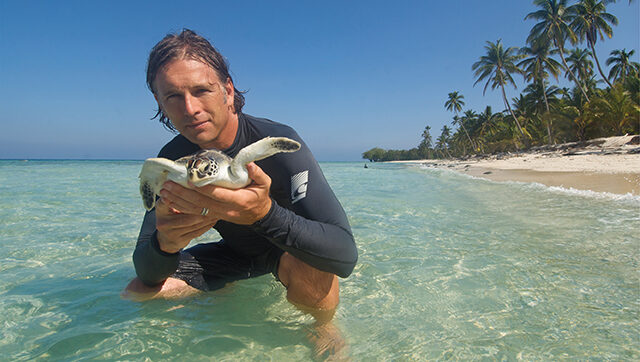I’m a bit shaky as I make my way up from all fours to standing on my paddleboard. “That’s it; great. Just move back a little bit,” urges Suzie Cooney, a professional competitive stand-up paddleboarder and coach. She has kindly agreed to take me out today off the southern shore of Maui, Hawaii.
I feel taller than on land, lanky and strangely disoriented. The beach where my friend awaits seems to be drifting farther and farther away. Oh, wait, it’s me that’s drifting.
I’m surprised by how much I can see from this vantage point; the coral reef below seems to go on and on. Out of the corner of my eye I see a shimmer — a school of butterfly fish. A breeze, warmed by the Hawaiian sun, tickles my skin, and my board gently rocks to the rhythm of the water.
Cooney is already in motion, her strong arms leveraging her paddle effortlessly, as if it were an extension of her body. I try to mimic her stroke but overreach, hinging too far forward and pushing down too hard. I nearly tip, but then right myself, softening my knees and dropping my shoulders as Cooney has instructed.
Once recovered, I engage my core, lift the paddle, then slice down and back through the water. I do it again and again until the motion begins to feel like a dance. I catch up to Cooney, and we glide silently for a few minutes parallel to the shore, Maui’s stunning volcanic mountain landscape in the distance.
Water Explorers
Maui is known for its great surfing; Honolua Bay boasts epic waves in the winter and plenty of observers to watch the surf pros battle nature. But increasingly, stand-up paddleboarding (SUP) is bringing nonsurfers out to explore the water off Maui’s beaches and coves. Today it’s common to see entire families on paddleboards as part of a vacation outing, and SUP has become a favorite activity among locals.
The primary reason for this popularity is ease. If you can swim, you can do SUP. It involves standing on a board that’s longer, wider and thicker than a surfboard — like a personal dock — and maneuvering through water with a long-handled paddle.
Thrill-seekers can head into rough water to catch the glide off bigger waves, while more leisurely types can take it slow on smooth water. When you want a break, just sit down (or lie down) until you’re ready to travel again.
Either way, SUP gets you out on the water safely, and far from shore, under your own power. “The draw is that it allows everybody to experience surfing, but it’s about catching the glide rather than catching the waves,” Cooney tells me. “It’s just so much more accessible.”
While SUP is “still in its infancy,” according to Reid Inouye, publisher of Standup Paddle Magazine, surf shops attest that its steady growth has been a huge boon for business. And SUP is also happening on lakes and rivers that are far from the coasts.
“It’s not something you need an ocean for,” says Todd Masinter, who with his wife, Sandy, owns Triangle Glides, which provides SUP lessons and sells boards, paddles and equipment in Raleigh, N.C. “Any body of water is good for stand-up paddling.”
Waikiki to Tahoe
While there is some debate as to the origin of SUP (some believe it dates back to ancient Hawaiian, Peruvian and African cultures), the modern-day sport originated on the Hawaiian Islands, with surf instructors using tall, lightweight paddles to guide their surfboards. In the early 2000s, a few pro surfers started using paddles to train, creating a buzz in the surf community and spawning a new recreational sport.
The user-friendly form soon attracted the attention of nonsurfers eager to enjoy the unique thrill of standing on water. Before long, SUP was its own industry, with longer, wider boards being developed in a range of designs and price points, making it easy for almost anyone to join in the fun.
“It’s the first time in a long time there’s been a sport that’s cool enough that the kids who always wanted to be surfers want to do it — and that their families want to do it, too,” says Ernie Brassard, cofounder of the first SUP race in the country, the Ta-Hoe Nalu.
Brassard, a lifelong surfer and outdoorsman who lives close to Lake Tahoe in Carnelian Bay, Calif., discovered the sport while on a surf trip to Cojo-Jalama Ranch near Santa Barbara. A friend had brought a 12-foot surfboard and was doing stand-up paddling. “We all had fun playing in the small surf with this big board. At that time it was still a novelty, though, not real surfing to us,” he says.
Shortly after, that same friend came to visit Brassard, ready to test the long board on the famously crystalline Lake Tahoe. Brassard, who is now 67, got hooked.
“I’d get up every morning and get out on the lake,” he recalls. The gentle motion of paddling helped him rehab a stiff shoulder after a biking accident. He had also put on weight over the years, so his incentive to paddle consistently “was pretty great,” he says.
Soon, friends from Tahoe who saw Brassard paddling got their own boards, and they spawned the idea of a friendly competition. The Ta-Hoe Nalu, a spin on the Hawaiian name for “paddle surf,” was born in 2007, with 34 people from around California paddling a seven-mile stretch of the legendary lake.
“After the event, all these kids were coming down wanting to try it, and we were letting everyone use our boards,” Brassard recalls. “It was really magical. That whole aloha spirit was alive in Tahoe that day.”
Relaxed Strength
Like Brassard, many who have fallen under SUP’s spell have inadvertently discovered its health benefits, which are both mental and physical.
Mike McGann, owner of Florida Paddleboards in Juno Beach, Fla., was a longtime surfer who now paddleboards almost exclusively. He found his way to the sport when he was itching to get out on the water, but the waves weren’t cooperating. “At first, my surfer friends made fun of me,” he recalls, but notes that most of them now love to paddle.
Today, McGann is interested in more than just ocean waves. He likes to explore the Intracoastal Waterway with its saltwater rivers, inlets and estuaries, where “you’re almost guaranteed” to see wildlife like stingrays and manatees. “It’s a therapeutic thing,” he says.
Cooney agrees: “There’s something that’s so calming about water for everyone.” And she believes the physical benefits are equally universal.
SUP is a terrific full-body exercise, says Cooney. While it’s particularly beneficial for core muscles, it goes beyond them, she notes. “It’s all the fine stabilizers, too. The hips, the knees, the ankles. Plus, you develop upper-body strength.”
Landscape of Possibility
One of the things SUP enthusiasts enjoy most about the sport is its versatility. It can be part of outdoor adventures in exotic locations or a calming daily ritual near home.
Stachia Fey, 42, a designer and yoga teacher who lives in Orono, Minn., discovered SUP five years ago after spotting a paddleboarder on a Minneapolis lake. “I had always wanted to surf, but to realize it was possible on a lake without waves — it looked so fun and relaxing,” she recalls. Fey rented a board on the spot, and instantly fell in love with the sport.
Fey has since done and taught SUP on lakes and rivers in and around Minneapolis, including teaching yoga classes on a paddleboard — a growing trend. Typically, though, she paddles on the lake in front of her house.
Like Fey, Betsy Held has made SUP a part of her adventures and everyday life. The 58-year-old lives in Ventura, Calif., and works for an outdoor-clothing retailer. She’s done SUP in a variety of locales: kelp beds and local harbors; the Channel Islands to explore watery caves; and the Colorado River, where she paddled a memorable 63 miles.
“We used the boards to carry all of our gear; we napped on them in little coves; we used them for wind blocks in our camps; and we sat on them to eat our lunches,” Held recalls. On some nights, her party donned headlamps and paddled in the dark.
One Halloween, she and friends put candles in carved pumpkins on the bows of their boards and paddled under a full moon. “The possibilities,” Held says, “are endless.”
Easy Riders
Who can SUP?
Anyone who can swim. Bryce Morris of Charles River Canoe & Kayak in Boston says he’s seen 70-year-olds getting into SUP, “and kids just love the things.”
Where to begin?
While SUP on calm water is easy to pick up, most enthusiasts suggest taking a lesson to start. You’ll learn the basics of standing on the board, how to hold and maneuver the paddle, and what to do in case you fall off. “Most people pick it up in a few minutes,” says Todd -Masinter, who teaches SUP in North Carolina. “But taking a lesson makes a massive difference in terms of comfort and safety.”
What does it cost?
Prices vary for lessons in different locations, but expect to pay around $60 for a 60- to 90-minute session, including equipment rental, instruction and time to practice on your own. The average cost to rent SUP gear is around $30/hour. If you want to purchase your own, SUP boards run between $700 and several thousand dollars; paddle: $85–$400; leash: $15–$40; flotation device: $50–$120




This Post Has 0 Comments